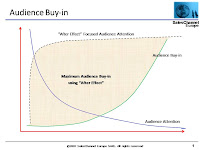 How many times have you had to sit through a really bad presentation or pitch? What was it about the pitch that made you bored, disinterested, frustrated or even angry? We all know a bad pitch when we experience one, but what does it take to make a really great pitch?
How many times have you had to sit through a really bad presentation or pitch? What was it about the pitch that made you bored, disinterested, frustrated or even angry? We all know a bad pitch when we experience one, but what does it take to make a really great pitch?
The key to making winning pitches lies in being able to answer these two questions:
– What are the 2 things that they want to hear?
– What are the 3 things that you absolutely, positively must do if you want them to buy you and your ideas? Let me answer this question first.
The 3 Platinum Rules of making winning pitches:
1. The message is all about them and not about you.
Do a quick check of your next pitch presentation. Are you starting out with an overview of your company: its history and position in your industry and why you are so good at what you do? Here is the bad news. The group you are pitching to doesn’t care about you or your company until they know that you understand and care them and their business, their goals for the future and the challenges they face getting there. When we talk about us and not them we fail to capture their attention and we fail to engage the group. But there is an other more serious consequence which is that we waste the best part of the groups attention span which decreases rapidly when we talk about “us”, and when we do finally talk about “them” they are at the low end of the attention curve (see diagram “Audience Buy-in”). In other words we actively minimise our chances to connect, engage and persuade our audience.
2. Establish relevance up front:
“Why” before “what”, “how”, “who” and “when. Focus on WIIFT (What is it for them) and avoid WIIFM (What is in it for me) thinking. Try this simple test. Take a yellow highlighter pen to your presentation pitch and mark every reference to your company, your brand, your product or service, your position in the market, your track record, your financials, etc. Then present what is left unmarked as your pitch. You may be alarmed to find that you don’t have much to say! Then do a quick check of your benefits statements. Remember the Golden Rule: Its not a benefit unless it has the word “you” in it. Example. At the end of the new campaign you will have revenues up by 15% in the current quarter and you will get complaints down by 25-30% over the following 2 quarters.
3. Focus on their better future not your brilliant past.
This means that you don’t talk about your reference customers, case studies, client testimonials, etc. until you have described how you will positively impact their business over time. This takes hard work. To have solid data on their better future you have to know where they are today, where they want to be tomorrow and know by how much you can help them get there and in what time frame. Once you have established this you can confidently talk about the After Effects: outcomes and results. By doing this you will be aligned with their No. #1 interest – how to achieve their mission, goals and objectives which will determine their success as individuals and as a group.
What are the 2 things that your audience wants to hear?
1) the After Effects. i.e. What do they get and when do they get it, and
2) they want certainty. Anticipate this need by answering the unasked question: How can I be sure and certain that you can and will deliver what you are pitching? This is where your case studies, customer references and client testimonials can be leveraged. As George Bernard Shaw said: “What men want is not knowledge, but certainty.” Make sure that your pitch delivers that certainty.”


I like this a lot.
I train people on presentation skills and this is a nice summary of where to put the emphasis i.e. on the client!